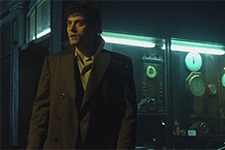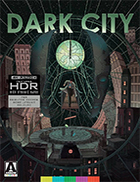Dark City (4K UHD)
|  As human beings, memories are our most cherished possession. They show that we are real, give evidence of our prior existence. In many ways, our memory is our identity—who we are in the world. So, what would happen if you couldn’t trust your memories as your own? What would happen if the past you had stored in your mind was not really yours? What if it belonged to someone else—or, possibly, to no one at all?This is the central question underlying Alex Proyas’s ambitious thriller Dark City. Part film noir, part science fiction, part fantasy, and part psychotic dreamscape, Dark City is a visual marvel of a cinematic experience. Flirting with, but never fully embracing coherence and logic, it takes on the striking essence of a visceral nightmare, where images flood and pour into one another, all drenched in inky darkness and bruised light. The film takes place in a city of perpetual night that is populated with people who are not who they think they are. It is every city and no city, an amalgam of urban landscapes culled from the visual files of film noir and Weejee’s photojournalism. It is, therefore, perfect terrain for Proyas, the Australian-born music video director who had made an immediate name for himself four years earlier with the brooding supernatural vengeance tale The Crow (1994), which also unfolded in a dark urban netherworld. Proyas has a knack for transforming the most fantastic vistas of the imagination into cinematic reality, which is exactly what he does here. More than anything, Dark City resembles Japanese manga and anime films like Akira (1988), both in style and substance. While anime is the stuff of ink and paint, Proyas molds his world using actors, expansive sets, and great douses of digital imagery, although it still maintains the wildly kinetic feel of something animated. The protagonist of Dark City is a seemingly ordinary man named John Murdoch (Rufus Sewell), who wakes up in a hotel room bathtub with a dead woman on the floor by the bed and confused memories in his head. He doesn’t remember who he is (he has to figure out his own name) or how he got to the hotel room; but, he has flashes of memory, some of which seem to suggest that he is a serial killer. He stumbles out of the hotel and into the city, desperate to find out who he is and what he has done. Is Emma (Jennifer Connelly), a beautiful nightclub singer, really his estranged wife? Did he really kill the woman in his hotel room, along with five others? If he didn’t, then why does he remember dropping the knife, and why is his coat pocket filled with newspaper clippings about the hunt for the serial killer? While he is trying to find answers to these questions, a dogged police inspector (William Hurt) is hot on his trail ... as are others. These others are known as the Strangers, and they hold all the answers to his questions. (Anyone not wanting spoilers to the film’s central mystery should bail out here.) Although they appear as creepy, pale-faced, bald men in black trench coats, they are actually a dying alien race that has come to Earth in desperation. They abducted a cross-section of humanity and, unbeknownst to these people, placed them in the titular city, which they constructed as a giant laboratory to conduct experiments. And what do they hope to discover in their research? Why, nothing less than the human soul. They want to know what it is about us that makes us human, so they can take it in order to preserve themselves from extinction. Every night at midnight, everyone in the city falls asleep as the Strangers literally stop time so they can alter the reality in which the people live. Buildings collapse into the ground while new ones rise up, twisting and forming like giant flowers. Barber shops morph into hotels, bridges disappear, tenement buildings turn into mansions, and so on. But, no one ever notices because, when they wake up, they think this is how it has always been. So much for trusting your memories. However, that is not all the Strangers do. They have selected one human, a psychiatrist named Dr. Daniel Schreber (Kiefer Sutherland), to help them. He concocts strange chemical formulas that create new memories. He can mix and match them, and while time is stopped, he goes about to various people, injecting new memories into their heads. So, a man who is a hotel manager when time stops wakes up as a newspaper salesman and never knows he was anything other than that. Or, in Murdoch’s case, he wakes up with the fragmented memories of a serial killer. But, with Murdoch, something went wrong, and the Strangers are desperate to find him because he may have taken on some of their powers. If this all sounds confusing, it is at first. However, the screenplay by Proyas, whose early drafts were expanded and elaborated by Lem Dobbs (Kafka) and David S. Goyer (Blade), develops this perhaps overly ambitious storyline into an almost plausible thriller that is high on excitement, but low on human drama. The story is an amalgam of so many others, merging the hard-boiled police dramas of the 1940s and ’50s with Philip K. Dick-style science fiction. The notion of having false memories implanted in one’s mind was a favorite of Dick’s, and it served as a primary plot device in his stories that were adapted for Ridley Scott’s Blade Runner (1982), Paul Verhoeven’s Total Recall (1990), Steven Spielberg’s Minority Report (2002), and John Woo’s Paycheck (2003). While the storyline is packed with philosophical questions and postmodern conundrums, what most will remember about Dark City are the visuals. The performances are all good, but the characters are mostly types—the struggling everyman, the tough detective, the confused spouse—and are therefore largely overshadowed by the world they inhabit. Dark City has grand production design and the feel of real vision, even if that vision is assembled from other parts. It is not hard to see traces of literally hundreds of films before it: from Fritz Lang’s Metropolis (1926), to Tim Burton’s Batman (1989), to Marc Caro and Jean-Pierre Jeunet’s The City of Lost Children (La cité des enfants perdus, 1995). Nevertheless, the world presented in Dark City is completely absorbing, drawing you in via a seamless combination of sets, miniatures, and digital technology. If it feels like an extension of the netherworld where The Crow took place, that is for good reason. Proyas recruited a large portion of the technical team that brought that film to life, including cinematographer Dariusz Wolski and editor Dov Hoenig. Working together again, Proyas and his team breathe life into a mystical world of strange aliens, marvelous machinery, and false dreams, creating a tangible yet surreal world that you can’t quite shake after the credits have rolled.
Copyright © 2025 James Kendrick Thoughts? E-mail James Kendrick All images copyright © Arrow Video | |||||||||||||||||||||||||||||
Overall Rating: 


 (3.5)
(3.5)


